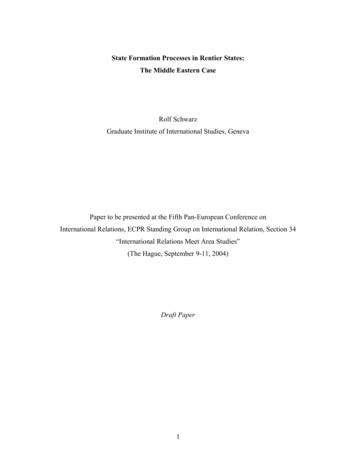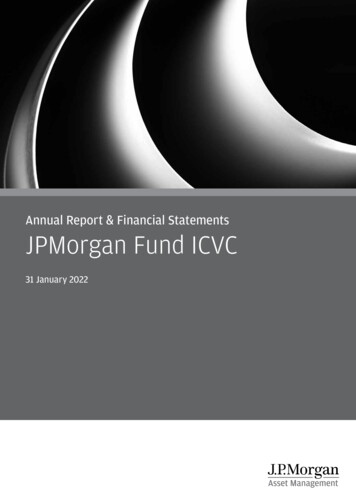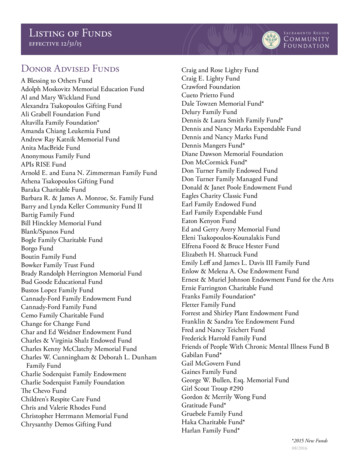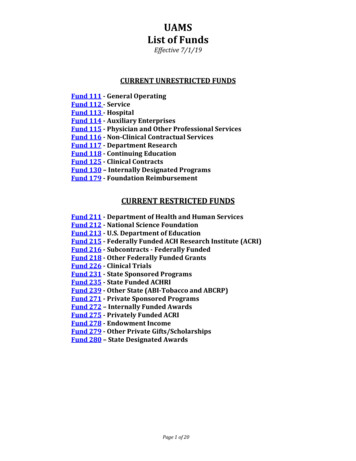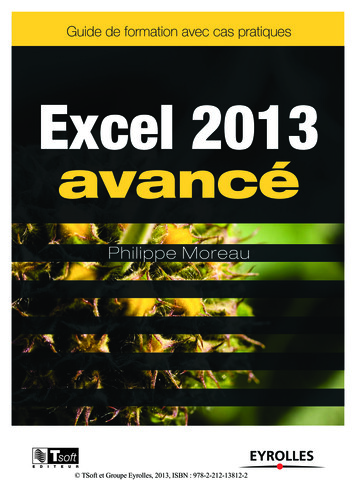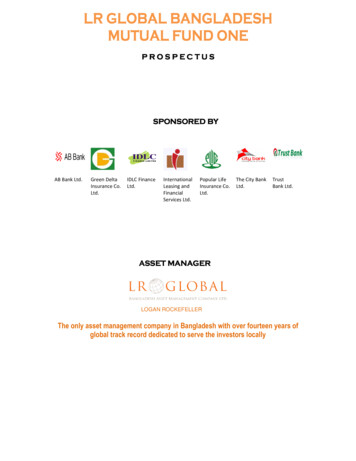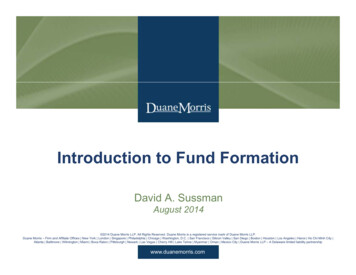
Transcription
Introduction to Fund FormationDavid A. SussmanAugust 2014 2014 Duane Morris LLP. All Rights Reserved. Duane Morris is a registered service mark of Duane Morris LLP.Duane Morris – Firm and Affiliate Offices New York London Singapore Philadelphia Chicago Washington, D.C. San Francisco Silicon Valley San Diego Boston Houston Los Angeles Hanoi Ho Chi Minh City Atlanta Baltimore Wilmington Miami Boca Raton Pittsburgh Newark Las Vegas Cherry Hill Lake Tahoe Myanmar Oman Mexico City Duane Morris LLP – A Delaware limited liability partnershipwww.duanemorris.com
Agenda 1Types of fundsStructural issuesKey documentsRegulatory issueswww.duanemorris.com
Types of Funds Hedge Funds– Typically invest in liquid, publicly-traded securities– Investors make capital contributions uponsubscription– Usually feature a one year lock-up, after whichinvestors may withdraw from the Fund– Allocates profits and losses based on realized andunrealized gains2www.duanemorris.com
Types of Funds Private Equity Funds– Make long-term, illiquid investments– Investors make “capital commitments” uponsubscription– Fund manager makes “capital calls” from theinvestors’ commitments– Allocates profits and losses based on realizedgains3www.duanemorris.com
Types of Funds – Fee Structures Hedge Funds:– Manager typically collects an annual managementfee: Set fee as an annual rate as a percentage of thetotal amount of the net asset value of theinvestments owned by the Fund (the “AUM Fee”)– Manager also collects an Incentive Allocation: Percentage of the Fund’s net realized andunrealized profits4www.duanemorris.com
Types of Funds – Fee Structures Private Equity Funds– Manager receives an annual Management Fee Early Investment Period: percentage of the Fund’stotal capital commitments Post-Investment Period: percentage of the Fund’sinvested capital– Manager also receives a Carried Interest Percentage of the Fund’s realized profits5www.duanemorris.com
Structure Formed as a limited partnership– Fund investors are the Limited Partners Sponsor forms one or two separate limitedliability companies Three-party structure vs. two-party structure6www.duanemorris.com
The Limited Partnership General Partner–– Limited Partners––– Passive investorsLimited liabilityPartnership interests are considered “securities”Flow-through tax treatmentFlexibility in management–7Often a limited liability company (”GP Entity”)Responsible for overall Fund managementBroad authority for GP Entitywww.duanemorris.com
Three-Party StructureManagement Company(Limited Liability Company)General Partner(Limited Liability Company)Invests in/administersFundManages investmentsfor FundFUND(Limited Partnership)Investin morris.com
Three Party Structure GP Entity receives Incentive Allocation/CarriedInterest Management Company of a Private EquityFund:– Receives the Management Fee Management Company of a Hedge Fund:– Receives the AUM Fee9www.duanemorris.com
Two-Party StructureGeneral Partner(Limited Liability Company)Invests in, administersand managesinvestments for FundFUND(Limited Partnership)Investin emorris.com
Two-Party Structure Hedge Fund:– GP Entity collects Incentive Allocation and AUMFee Private Equity Fund:– GP Entity collects Incentive Allocation andManagement Fee11www.duanemorris.com
Key Documents 12Private Placement MemorandumLimited Partnership AgreementSubscription BookletGP Entity LLC AgreementManagement Company LLC AgreementInvestment Management Agreementwww.duanemorris.com
Private Placement Memorandum (“PPM”) –Sets forth key information about the Fund 13Investment strategyRisk factorsInformation about GP Entity and Management CompanyManagement Fee/AUM Fee/Incentive Allocation/CarriedInterestOther fees/expensesConflicts of InterestTax mattersSynopsis of Limited Partnership Agreementwww.duanemorris.com
Limited Partnership Agreement –Parties: GP Entity and Limited Partners t/purposeLimitation of liabilityManagementIndemnificationFeesFund expensesTax mattersValuation of AssetsAssignment and transferwww.duanemorris.com
Limited Partnership Agreement –Parties: GP Entity and Limited Partners–Hedge Funds: –Private Equity Funds: ––––15Capital accountsAllocationsDistributionsCapital contributionsCapital commitmentsCapital callsDistributionsDefaulting Limited PartnersHedge Funds: admission/withdraw provisions“Key Man” provisionsGP Entity removalBooks & records/Periodic reportingwww.duanemorris.com
Subscription Documents –Confirm Investor’s obligation to purchase fund interests - Providesimportant information about an Investor Importance of Subscription Documents– Exemptions– Duty to update Investor Information– Identifying information– Amount of commitment16www.duanemorris.com
Subscription Documents –Confirm Investor’s obligation to purchase fund interests - Providesimportant information about an Investor– Representations and warranties Type of investor (individual or entity); Net worth NASD New Issues Rule Acknowledgements (receipt of documents, questionsanswered, etc.) Accredited investor, qualified purchaser and/or qualifiedeligible person status Acknowledgement of unregistered/restricted status of Fund Indemnification provisions– Investors that are private funds or “benefit planinvestors” – 1940 act and ERISA exemptions– Confidentiality17www.duanemorris.com
Regulatory Issues 18Securities Act of 1933Investment Advisers Act of 1940Investment Company Act of 1940Securities Exchange Act of 1934www.duanemorris.com
Registration of Offer and Sale of FundSecurities Under the 1933 Act Interests in a Fund are “securities” under 1933Act Exemptions– Section 4(2) of the 1933 Act Private placement exemption– Regulation D Safe harbor that qualifies offerings for exemptionunder Section 4(2) Reduces uncertainty and specifies objective criteria19www.duanemorris.com
Regulation DAccredited Investors 20Rule 506 is most relevant for FundsExemptions for offerings made exclusively to “accredited investors”Accredited Investor Criteria Generally:– Natural person with net worth in excess of 1 million. The “net worth” test: (i)excludes the value of the investor’s primary residence; and (ii) provided that suchindebtedness was incurred prior to 60 days before the investor’s investment intothe fund, excludes the amount of liabilities secured by the investor’s primaryresidence unless and to the extent that such liabilities exceed the value of theinvestor’s primary residence.– Natural person with an annual income of: Individually: 200,000; Jointly: 300,000– Trust with assets in excess of 5,000,000– Any entity beneficially owned exclusively by accredited investorswww.duanemorris.com
Regulation DGeneral solicitation or advertising 21Prior to the enactment of the Jumpstart Our Business Startups Act (the “Jobs Act”), generalsolicitation was prohibited in connection with Regulation D offerings.The Jobs Act amended the general solicitation rules and, in July, 2013, the SEC issued final rulesallowing for the general solicitation in Regulation D offerings provided that the investors are allaccredited investors and the issuer takes reasonable steps to verify each of the investor’s accreditedinvestor status.Whether the issuer has taken “reasonable steps” to verify accredited investor status is a facts andcircumstances analysis. However, the SEC has issued a non-exclusive and non-mandatory list ofways in which issuers will be deemed to satisfy the verification requirement as long as the issuerdoes not have knowledge that the investor is not an accredited investor. The list includes thefollowing: (i) review of the investor’s tax return for 2 years and also receive a written statement thatthe investor expects to reach the income necessary to qualify, (ii) review 3 months’ worth of financialstatements and also receive a representation that the investor has disclosed all liabilities necessaryto make a net worth determination, (iii) the issuer may receive 3rd party verification from a registeredbroker-dealer, a registered investment advisor, a licensed attorney, or a licensed accountant; and (iv)the issuer may receive written certification from an existing investor that such investor still qualifiesas an accredited investor.Based upon these rules and verification requirements, most funds are well advised NOT toengage in general solicitation.www.duanemorris.com
Regulation D –Other considerations Investors must not invest with a view todistribute interests to the public Form D filing Exemption from State Registration/Blue SkyLaws– National Securities MarketsImprovement Act of 1996– Notice filings22www.duanemorris.com
Advisers ActSmall Adviser Exemption Before Dodd-Frank Act 23Prior to the enactment of the Dodd-Frank Wall Street Reform and Consumer ProtectionAct in 2010 (the “Dodd-Frank Act”), the GP Entity and/or Management Company: Was required to register with the SEC if it had 30 million or more of “assetsunder management” Was allowed to register with the SEC if it had at least 25 million or more of“assets under management” Small Adviser Exemption: However, small advisers were not required toregister with the SEC even if they had 30 million or more of assets undermanagement. “Small Advisers” were investment advisers that: (i) had fewerthan 15 clients in preceding 12 months, (ii) did not advise registeredinvestment companies or business development companies, and (iii) did not“hold itself out to the public” as an investment adviser. The ManagementCompany typically satisfied this exemption because the Fund qualified as asingle client.www.duanemorris.com
Advisers ActRegistration Requirements Post-Dodd-Frank Act New Thresholds for SEC Registration: The Dodd-Frank Act significantly changed the landscape for investmentadvisers. Generally, investment advisers are subject to the new threshold amounts for registration: (i) investmentadvisers with less than 25 million of assets under management (“small advisers”) are generally prohibited fromregistering with the SEC and must register with the state regulators unless an exemption applies, (ii) investmentadvisers with 25 million to 110 million of assets under management (“mid-sized advisers”) are generally prohibitedfrom registering with the SEC and must register with the state regulators unless an exemption applies but there is abuffer for advisers between 100 million and 110 million, and (iii) advisers with 110 million are required to registerwith the SEC. Exemptions from Registration with the SEC: 24 Advisers only to Venture Capital Funds Advisers only to Private Funds with less than 150 million in assets under management Advisers that are Foreign Private Advisers Advisers only to Small Business Investment Companies (“SBICs”) Advisers only to Family Offices Intrastate AdvisersObligations of Investment Advisers that are Exempt from Registering with the SEC: Notwithstanding that aninvestment adviser may not be required to register with the SEC, such advisers may be subject to certain SEC rules,relating to: (i) the anti-fraud provisions, (ii) the pay-to-play rules, (iii) certain supervisory requirements, and (iv)principal transactions rules. Further, investment advisers relying on the Venture Capital Funds or Private Fund’sexemptions from registration, such advisers will be considered “Exempt Reporting Advisers” and required to a subsetof the Advisers Act rules, including, submitting a truncated version of the Form ADV and be subject to SECexaminations.www.duanemorris.com
Advisers ActCompliance Requirements for SEC Registered Investment Advisers Investment advisers that are registered with the SEC, generally, will become subject tothe full scope of the Advisers Act. These include: 25Filing current disclosures on Form ADVSatisfying certain record-keeping requirementsBeing subject to SEC Office of Compliance examinationsEstablishing, maintaining, and implementing compliance programs (includingwritten policies and procedures reasonably designed to prevent violations ofthe Advisers Act or other securities laws, proxy voting policy, insider tradingpolicy, and code of ethics, designating a Chief Compliance Officer tasked foradministrating the firm’s policies and procedures, performing periodic trainingon policies and procedures, and performing compliance reviews at leastannually)Satisfying the SEC’s Custody RequirementsComplying with advertising rulesRemaining subject to restrictions on performance feeswww.duanemorris.com
Investment Company Act Most Common Exemptions:– Section 3(c)(1) Funds Not making or proposing to make a public offering Beneficial ownership is limited to fewer than100 persons– Section 3(c)(7) Funds Not making or proposing to make a public offering All owners must be “qualified purchasers”26www.duanemorris.com
Investment Company Act – 3(c)(1) Funds 100 Beneficial Owner Limit– Natural persons: Individuals Spouses holding interests jointly Involuntary transfers do not increase the number ofbeneficial owners– Entities: Companies that own 10% or more of the Fund 27Look-through to beneficial ownersOnly applies to other Funds and Investment Companieswww.duanemorris.com
Investment Company Act – 3(c)(1) Funds Prohibition Against Public Offerings– Generally satisfied by complying withRegulation D prohibitions28www.duanemorris.com
Investment Company Act – 3(c)(7) Funds Exclusive ownership by “Qualified Purchasers”– Natural persons who own not less than 5 million ininvestments– Family companies that own not less than 5 million ininvestments– Trusts with a trustee and settlor who are qualifiedpurchasers– Institutional buyers that own and invest on adiscretionary basis not less than 25 million ininvestments– Companies in which each beneficial owner of thecompany’s securities is a qualified purchaser29www.duanemorris.com
Investment Company Act – 3(c)(7) Funds Prohibition Against Public Offerings– Generally satisfied by complying withRegulation D prohibitions30www.duanemorris.com
Exchange Act Broker-Dealer Registration– Broker: any person engaged in the business ofeffecting transactions for the account of others Funds are not brokers because any trading activity isdone for their own account– Dealer: any person engaged in the business of buyingor selling securities for such person’s own accountthrough a broker or otherwise Funds are not dealers because they are not consideredto be “in the business” of buying and selling securities– Funds are considered to be “traders” that buy and sellfor investments generally31www.duanemorris.com
Exchange Act Section 12 of the Exchange Act Prior to the enactment of the Jobs Act, Section 12(g)required issuers to register a class of equity securities withthe SEC if, on the last day of the issuer’s fiscal year, suchclass of securities was held of record by 500 or more recordholders and the issuer had total assets of more than 10million. Title V of the Jobs Act amended Section 12(g) of theExchange Act which now provides that an issuer willbecome subject to the Exchange Act requirements within120 days after the last day of its fiscal year on which theissuer has total assets in excess of 10 million and a classof equity securities (other than exempted securities) held ofrecord by either: (i) 2,000 persons, or (ii) 500 person whoare not accredited investors.32www.duanemorris.com
Further informationDavid Sussman, Partner, Newark, NJdasussman@duanemorris.com 1 (973) 424-201133www.duanemorris.com
Introduction to Fund FormationDavid SussmanAugust 2014 2014 Duane Morris LLP. All Rights Reserved. Duane Morris is a registered service mark of Duane Morris LLP.Duane Morris – Firm and Affiliate Offices New York London Singapore Philadelphia Chicago Washington, D.C. San Francisco Silicon Valley San Diego Boston Houston Los Angeles Hanoi Ho Chi Minh City Atlanta Baltimore Wilmington Miami Boca Raton Pittsburgh Newark Las Vegas Cherry Hill Lake Tahoe Myanmar Oman Mexico City Duane Morris LLP – A Delaware limited liability partnershipwww.duanemorris.com
advisers. Generally, investment advisers are subject to the new threshold amount s for registration: (i) investment advisers with less than 25 million of assets under management ("small advisers") are generally prohibited from registering with the SEC and mu st register with the state regulators unless an exemption applies, (ii) investment
